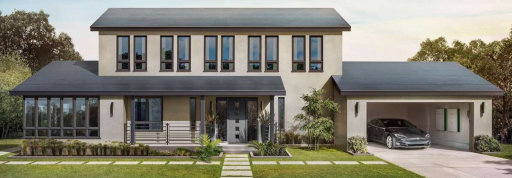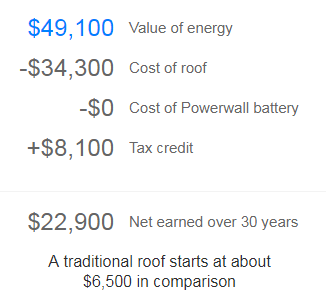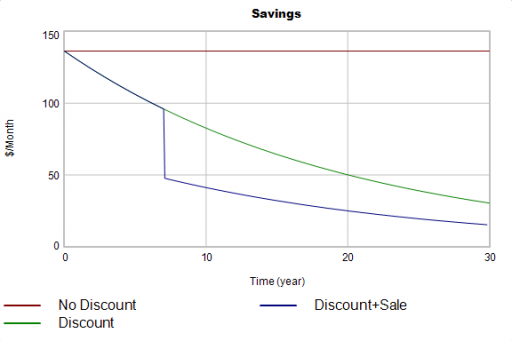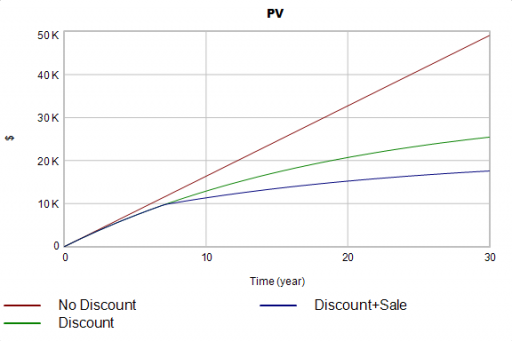No one buys a Tesla Model S because it’s cheaper than a regular car. But there’s currently a flurry of breathless tweets, rejoicing that a Tesla roof is cheaper than a regular roof. That’s dubious.

When I see $21.85 per square foot for anything associated with a house, “cheap” is not what comes to mind. That’s in the territory for luxury interior surfaces, not bulk materials like roofing. I’m reminded of the old saw in energy economics (I think from the EMF meetings in Aspen) that above 7000 feet, the concept of discount rates evaporates.
So, what are the numbers, really?
The source for all the excitement is frequently this Consumer Reports article – really an offhand blog post. A follow up does the math again using Tesla’s own calculator. None of these sources has any concept of discounting or opportunity costs.
What if you do believe in time value of money? There are lots of complexities, like how you finance a $65,500 capital outlay, but let’s set that aside and consider a cash purchase of a new roof, with the savings expected to generate a reasonable return.
Then there are four issues:
- What’s a reasonable return? (Let’s say 5%)
- Will the stream appreciate as utility rates escalate? (Let’s assume not for simplicity. If everyone goes solar, grid rates might actually fall.)
- Are there costs, like maintenance and insurance, associated with the investment? (Let’s assume 0 for optimistic simplicity.)
- How long will the stream last? Houses turn over, so there are really several issues here: durability of the system (30 years), time you expect to own it (7 years is typical), and the discount subsequent buyers will apply (presumably large due to widespread ignorance and difficulty of financing – say 50%).
Let’s do my mom’s house in California (an advantageous location for solar). Tesla calculates:

So, the Tesla roof has a $29,400 advantage over a regular roof. However, the value of energy here is undiscounted – it’s a simple accumulation of $136/month over 30 years*12 months.
Here’s the discounted version, with my assumptions above:

Discounted value of the flow of avoided energy costs over time.

Present value of avoided costs cumulated over 30 years. Note that, with discounting, life extension beyond 30 years doesn’t have much impact, because the discounted contribution at 30 years is already small.
The bottom line is that if you expect an ROI, the present value of the stream of avoided electricity costs is about half as big ($25,400), or a third as big ($17,600) if you sell your house and buyers aren’t sophisticated. That makes the bottom line, net of a conventional roof, somewhere between $5700 and -1800. Note that any advantage is entirely contingent on the Federal tax credit.
Other Issues
- Equity. This isn’t Tesla’s problem; it’s our problem. Does it make sense for the public to pay 30% of the cost of an ultra-premium roof, when much of the area will be non-generating tiles that serve exclusively as roofing? How much of that tax credit will ever accrue to the bottom income quartile?
- Emissions. Rather than subsidizing generation, we really ought to be pricing emissions, so that the energy cost calculations above reflect the public value of avoiding climate change and local health impacts of air quality. That term will vary a lot regionally.
- Baseline. The Tesla roof mingles roofing and generating. So, the point of comparison should be a conventional roof with a conventional PV panel system or separate green power purchase.
- Other opportunities. Efficiency generally beats renewable production, so one should be looking at demand reductions: insulation, windows, etc. These aren’t as sexy but do a lot for comfort as well as energy savings. If you don’t look at these items first, you might be sizing your PV system for unneeded load, which puts you at risk for future expiration of net metering provisions.
Should you get one?
Sure. If you need a roof, and have the capital, it looks like a darn nice option, with some distinct benefits beyond the power generated. You’d certainly be doing the global carbon cycle a favor, particularly if you’d otherwise spend the $ on air travel. Pocket your tax credits and rejoice in a small victory over the system. But then write to your representatives and ask them for a big fat carbon tax. That will really motivate a low-carbon economy, and increase the value of your roof!
